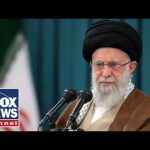In the latest turn of events, the United States military has ramped up its response to threats from Iran, resulting in a highly coordinated strike that will be remembered as one of the most significant military operations in history. The Pentagon announced that a formidable force, including seven stealth bombers and a multitude of support aircraft, took to the skies and struck at the heart of Iran’s nuclear facilities. This operation was truly impressive, as the U.S. military showcased its advanced capabilities and precision weaponry in a mission that involved the use of over 75 precision-guided munitions.
The attack featured a remarkable combination of technology and strategy. Stealth bombers began their long journey from Whiteman Air Force Base in Missouri, flying thousands of miles across various terrains while being supported by tactical fighter jets that provided a shield against enemy defenses. These fighter jets served as decoys, creating a smokescreen for the true mission—neutralizing Iran’s nuclear capabilities targeted at the enrichment facilities located in Natanz and Fordow. In a demonstration of strategic planning, the bombers deployed bunker-buster bombs capable of penetrating deep underground facilities, ensuring that the targets were effectively neutralized.
The operation involved a staggering amount of firepower and coordination. The military launched approximately 30 Tomahawk cruise missiles from a U.S. submarine, striking key locations to further weaken Iran’s nuclear ambitions. The various components of the attack, including strategic air and sea-based strikes, came together seamlessly to execute what could only be described as a well-orchestrated performance that would leave any military analyst impressed.
Despite the strength displayed during this mission, U.S. Defense officials have reassured the public that this military action is not about regime change. Instead, the goal is to send a clear message that the United States will take necessary actions to protect its interests and those of its allies without an indefinite commitment to conflict. This measured approach aims to deter further aggression while maintaining the capability for swift and decisive action when needed.
Now, as U.S. bases in the region remain on high alert, the focus shifts to what Iran’s next move might be. Military analysts suggest that with their vulnerability exposed, Iranian forces may look to retaliate in some capacity, although the U.S. now possesses a strong tactical advantage. The delicate balance of power in the region hangs in the balance, and all eyes will be watching for Iran’s response. In the face of threats, the U.S. military stands ready, showcasing a formidable presence that asserts its role as the premier global military power.




